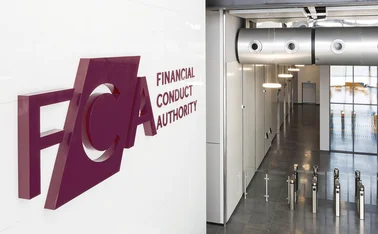
In Depth: Ogden outrage – dismantling the discount rate

Need to know
- Reinsurance rates could increase by up to 400% for higher layer reinsurance
- Rate change will cost NHS £5.9bn
- ABI branded the decision ‘bizarre’
The decision to cut the Ogden discount rate for the first time in 16 years sent shock waves through the industry that will be felt for months and years to come.
Though a change to the rate had become inevitable, with reform having been on the agenda for a number of years, Lord Chancellor Liz Truss’s shock decision to cut the rate from 2.5% to minus 0.75% pulled the rug from underneath the feet of the industry, sparking falling shares, delayed results and crippled profits.
The decision sparked outrage throughout the industry, with a cohort of the UK's top insurance CEOs rushing to Westminster on the day the new rate was set to confront Chancellor Philip Hammond directly.
“The industry asked for the rate to be stopped altogether, but we were given no comfort on that at all,” said Huw Evans, director general at the Association of British Insurers. “The statutory instrument had already been laid in parliament ahead of the meeting.”
Instead, the Chancellor reiterated Truss's promise that a consultation to review the rate would be started as soon as possible. With the consultation set to begin before Easter, Post examines the controversy surrounding the new rate, and what will happen to the industry if it remains the same.
Dents to profit
Insurers immediately began to see huge dents to their 2016 full year profits as they set aside reserves in anticipation of the rate change.
Aviva posted an exceptional charge of approximately £385m, with Direct Line, Admiral and QBE all taking hits of £230m, £105m and £129m respectively.
Ogden: impact on results
- Aviva posted an exceptional charge of approximately £385m as a result of the change
- Direct Line took a hit of £230m to its full year results
- QBE took a hit of £129m to its full year results
- Admiral took a hit of £105m to its full year results
After analysing the public statements made by insurers, Deloitte insurance partner James Rakow estimated a total market impact on reported results of £2bn, or 18% of the motor market net written premium.
Allianz general manager for commercial and personal Simon McGinn said: “It’s only been a fortnight since the new discount rate was announced, but already we can begin to see the impact. We are putting the necessary price increases through the market.
“Last week we picked up a sizeable personal injury claim through the liability cover of a policy on our packages account. The future loss component of the reserve on the new discount rate was £5.1m, under the previous discount rate it would have been £3.8m.
“This was by no means an extreme example, indeed the claimant here was 51 years old, so future losses would have been much greater if he had been younger at the time of the accident.”
Experts say the worst is yet to come, however. Speaking to Post after announcing the £230m hit, Direct Line CEO Paul Geddes said: "The unknown impact will come later in the year when people start to get their reinsurance negotiated. It will be interesting to see what that means for the market."
It is not yet known what the impact on reinsurance rates will be as a result of the change, though they are expected to rise dramatically. Motor insurers that rely heavily on reinsurance are expected to see their costs soar as they renew throughout the year.
Impact on reinsurance rates
PWC general insurance leader Mohammad Khan said: "The impact on reinsurance rates could be significant. For lower layer reinsurance, something like £1m in excess of £1m, or £3m in excess of £2m, rates could rise in the order of 50% to 75%.
"For the higher layers, say for example £5m in excess of £5m, or even above £10m, the rates could increase by 100% to 400%."
Khan said that if there is no new rate set as a result of the consultation, the date on which insurers renew their reinsurance will have little impact on rising rates.
“For those renewing on 1 April, your rates will rise significantly,” he said. “If you renew on 1 July, assuming nothing changes with the consultation, there will still be significant rate rises. By the time we get to 1 January, there will still be rate rises even with the impact of competition.”
Esure, which took a relatively small hit of £1m from the rate change, has reinsurance rates at around 7% of premium. CEO Stuart Vann said he was not concerned about reinsurance rates rising, as pushing rates up with the rest of the market will cover potential hits when the company’s treaties come up for renewal on 1 July.
“Ogden is a two-wave process,” he said. “The first wave is the initial impact on people’s back books. The market has started to increase prices on the back of that first wave. We don’t need to, as we haven’t taken that hit. But we will take the opportunity to follow the market and put rates up.
“Wave two comes down to reinsurance cost, because inevitably reinsurance costs will go up on the back of Ogden. My belief is that the rating we’ll be able to achieve on the back of wave one, when we don’t need to put rates up, will cover the increasing costs of our reinsurance.”
Khan predicted, however, that the outlook may look bleaker for reinsurers themselves. “Reinsurers will get pickier about the types of risks they want to reinsure,” he said. “So it may be the case that some reinsurers offer less capacity. That’s more likely than them withdrawing completely.
“The difficulty for the reinsurers, however, is that for a few years now there’s clearly been overcapacity in the market and lots of competition. The competitive nature of the market may erode the price increases they would like to push through.”
James Rakow, insurance partner at Deloitte, said: “We will see very substantial increases in reinsurance rates, both at the renewals at the middle of the year, and at the beginning of the year, which is when the vast majority renew. While we’ll get a steer in July, we’ll have to wait until the end of the year to see where the majority of increase lands.”
Rupert Swallow, CEO of Capsicum Re, said: “There will be a material impact on reinsurers following the decision by the Lord Chancellor to cut the Ogden rate from 2.5% to minus 0.75%, but that impact will be mitigated by rates for policyholders increasing.
“It will be keenly felt more on the excess of loss side as pro-rata reinsurance follows the fortunes.
“As with all seismic changes there are opportunities. This decision will inevitably create a hardening market for motor reinsurance so we might see new participants entering the market as well as old participants, that have not been in the market recently, return.
“Access to capacity is not necessarily going to be an issue, capacity to write the product will be available from the reinsurance market. “
Flawed methodology
In a twitter poll of insurers conducted by Post, 29% of respondents believed the rate should have remained unchanged at 2.5%. 67% thought it should have been set between 0% and 2.5%, with 4% saying it should have been set between minus 0.75% at 0%. None of the respondents believed it should have been set at its new rate of minus 0.75%.
The Association of British Insurers argues that the methodology on which Truss’s decision was made is flawed, as it does not accurately reflect how claimants invest the damages awarded to them.
Huw Evans, director general, said: "The law that governs this, both the 1996 act and the 1998 Wells judgement which the Ministry of Justice has used as justification for the approach it has have taken, both predate the introduction of periodic payment orders in the market.
"At the point that legislation was put in place, if you were a no risk claimant you had to have something offered to you through the discount rate that would reflect that. Now, if you choose not to take a periodic payment order, you are by definition a low risk claimant rather than a no risk claimant.
“That’s the way the law needs to be changed. This is not about trying to short-change claimants, this is about making sure we have a formula for the modern world, not the bizarre formula we’ve got at the moment which assumes that a claimant will take their money and invest it in a way that guarantees that it will start to lose value on day one.
“That’s a patently ridiculous formula and as an industry we support reform, not the status quo.”
There is some ambiguity as to how claimants actually do invest however, with no data readily available to either insurers or the public on what happens to awarded damages post-settlement.
The Association of Personal Injury Lawyers, which says that its threat of legal action against the government triggered the change to the rate, claims that the majority of claimants invest in government bonds and other "cautious" investments.
"We've been campaigning for the best part of six years on this," said Neil Sugarman, president of Apil. "We brought judicial review proceedings around six years ago. We were able to withdraw those proceedings on the basis that it triggered a process under which the then Lord Chancellor agreed to start the process of the review.
"One way or another that process dragged on and on. So we then had to re-threaten a judicial review, which has resulted in the recent review. So we are largely responsible for forcing the Lord Chancellor's hand.
“What we do know, and I can say this with some authority of experience because I’ve been doing this for 35 years, is that people who have been injured are generally very cautious investors. Primarily we’re talking about people who have very severe injuries.
“These are people who may have spinal cord damage, may have lost limbs, or may have brain damage. They’re generally the most serious kind of injuries, and so by definition they are highly unlikely to be able to get back to work. That means that they are very cautious, and that’s been my long experience. Gilts and government equities, that’s a cautious investment and that’s why people do it.
“These people I have mentioned have been waiting a very long time for the change to be bought about. The insurance industry trying to get the rate changed within the year creates great uncertainty at a time when people have at last had some certainty after many years.”
Forum of Insurance Lawyers president Nigel Teasdale does not agree with Sugarman's assessment, however. "The figure is not appropriate, in short," he said.
“Let’s be clear, claimants don’t invest in index linked government securities. Claimant representatives often have their own investment arms that make money on the investments made. And you can be sure that they don’t advertise that they’re going to make a minus 0.75% return over a lifetime.
"It's an ill informed decision to announce a change to the discount rate after 16 years and then immediately say that the way it is set is wrong and needs reform. It would make more sense to reform it first. Truss has put the cart before the horse. The effect of that is the taxpayer filling the £5.9bn black hole in the NHS, stock market volatility, and premiums going up."
Real world investment
Mark Burton, who leads Kennedy's Catastrophic Injury Team, agreed: "Truss was wrong not to consider real world investment strategies and to review the whole methodology of the discount rate, because not everyone invests 100% in gilts.
"We on the defendant side unfortunately don't have the visibility over where the money goes post-settlement. It's a frustration and it would be helpful for the purpose of the consultation if there was some evidence over what claimants actually do with their money. Because we never find out.
“There is always inbuilt flexibility and personal choice for claimants. They’re not necessarily by nature the lowest risk cohort of people, and there are plenty of examples in the market of other things they do with their money.
“We’re also only talking about cases where people are being fully compensated and are not taking any blame themselves. But we deal with all sorts of cases.
“Say, for example, a pedestrian steps out in front of a car without looking and only receives 60% of their damages; they are never going to be fully compensated and are, therefore, forced to be creative in their investments, to make their damages stretch.”
Regardless of what the rate should actually be set at, one thing that is not contested is that the Lord Chancellor's decision to open a consultation immediately after setting a new rate will cause a slowdown in claims processing.
Teasdale said: "A lot of people are waiting to see what this means, and there's a real uncertainty in the courts as well. There will be more delays whilst we wait and see what the final outcome will be because of that acknowledgement that it has to change again."
Only users who have a paid subscription or are part of a corporate subscription are able to print or copy content.
To access these options, along with all other subscription benefits, please contact info@postonline.co.uk or view our subscription options here: https://subscriptions.postonline.co.uk/subscribe
You are currently unable to print this content. Please contact info@postonline.co.uk to find out more.
You are currently unable to copy this content. Please contact info@postonline.co.uk to find out more.
Copyright Infopro Digital Limited. All rights reserved.
As outlined in our terms and conditions, https://www.infopro-digital.com/terms-and-conditions/subscriptions/ (point 2.4), printing is limited to a single copy.
If you would like to purchase additional rights please email info@postonline.co.uk
Copyright Infopro Digital Limited. All rights reserved.
You may share this content using our article tools. As outlined in our terms and conditions, https://www.infopro-digital.com/terms-and-conditions/subscriptions/ (clause 2.4), an Authorised User may only make one copy of the materials for their own personal use. You must also comply with the restrictions in clause 2.5.
If you would like to purchase additional rights please email info@postonline.co.uk








